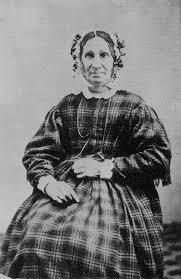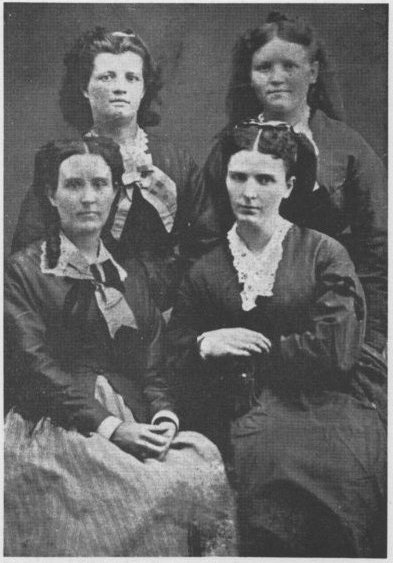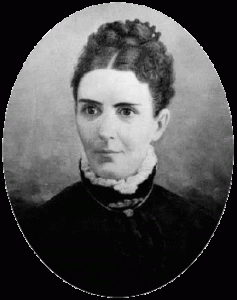Did you know that the early days of The Church of Jesus Christ of Latter-day Saints, midwifery was a spiritual calling? A woman was called to be a midwife by priesthood authority, often after having been nominated by the Relief Society, and set apart by the laying on of hands. She was usually set apart by a General Authority of the church, if available, and the calling was for life, much like the calling of Patriarch.

Patty Bartlett Sessions
The first woman we know of who was set apart as a midwife was Patty Bartlett Sessions, who is probably the most famous of the early church midwives and who personally delivered at least 4,000 babies during her life time. As a young girl, Patty received a strong spiritual confirmation about her calling as a midwife and had been working as a midwife for many years before she joined the church. When she arrived in Nauvoo she was set apart by Brigham Young and Heber C. Kimball as a “Doctor of Women” and went on to deliver thousands of babies for the LDS community. (Sessions, 1997).
During the early days of the church, hundreds of women were set apart as midwives. Some had formal training before their calls but others didn’t. My favorite story is of Josephine Catherine Chatterly Wood, of the Escalante area. When she was twenty-nine years old and the mother of several children, her Bishop called her to be the midwife of the community. At first she refused, saying, “I am green as a cucumber and I don’t know how babies are born.”
The Bishop promised to give her a blessing, and in the blessing he told her that she would be guided by the Lord and that great wisdom would be hers. Still feeling overwhelmed and inadequate, Josephine read all the books she could find and prayed and studied tirelessly. Before her first call to a mother in labor she asked her husband to give her a blessing, then, Josephine she went to the Bishop’s house and made him come with her to the birth because she was so nervous. The birth went well. Yet for several years afterward, Josephine would occasionally call the Bishop to come help her with the delivery of a baby.
Caroline Redd, one of the women who was attended by Josephine for eight of her births, said this of her: “None served more or gave more than she, and none was loved more. She loved to do the thing she was called to do. She loved her husband and family. She never complained. God gave her wisdom and power because she could translate pain into joy.” (Noall, 1942)In general though, most LDS midwives had some sort of formal training. Later-day Saints were very unique in this respect in19th America when few midwives had any sort of training.
The reason LDS women were so highly skilled in midwifery was for several reasons. Some of the early women coverts to the church came to Salt Lake City from Europe and had studied midwifery at schools in Scotland and France. Also, Brigham Young felt deeply about properly caring for prospective mothers and was particularly impressed by the trails and tribulation that women suffered when they had to “go down to the Valley of death” to bring forth the new citizens of Zion.
Even though Brigham Young had a real mistrust of doctors, which was probably very valid considering most of them didn’t have any sort of training, he eventually changed his mind and in 1880’s he started sending women to medical school to learn obstetrics. It was around this time that germ theory was being adopted. Germ Theory had been discovered in the 1860’s, and the medical profession was starting to become more research based and professionalized. Perhaps Brigham Young was inspired to hesitate about doctors until the saints could be assured that they were getting quality medical training and care.
Dr. Ellis Shipp was the first woman sent by Brigham Young to the Woman’s Medical College in Philadelphia to study medicine and obstetrics. After she returned from studying medicine she traveled all over the Mormon territories training hundreds of women as midwives and in the basics of home nursing. In fact, during the 19th century Utah had one of the largest numbers of women doctors than almost anywhere else in the world. (Dorigatti, 2009)The need for midwives in the newly established Zion was so great that in each Ward, the Relief Society would nominate two women to be trained and set apart as midwives for the women of the ward. These prospective midwives would usually travel to a place where Dr. Shipp, or another traveling doctor, was holding a temporary midwifery clinic. Since the time commitment was great–at least three months, and the cost very expensive (the cost the book was $20, which was a small fortune back then), the Relief Society of each ward would pay for their books and then feed and watch over their husbands and children while they were away.
One midwife who gained her training this way was Phebe Amelia Richards Peart, a midwife in Farmington. Her daughter said, “When she was on her first case, she decided that some day she would be a midwife…. Knowing how greatly midwives were needed, she looked forward to the day when she could study for this profession…. Some four years later, after she had become Mrs. Jacob Peart Jr., she laid her plans before her husband and also her mother, Mary Thompson Richards. She asked their permission and their help in taking a course of study under Dr. Shipp. It was, however, obvious, from the start that she could expect neither encouragement nor help from her family. Both her husband and her mother were bitterly opposed to the suggestion. They held to the then popular conviction that a woman’s place is in the home. To them it seemed unthinkable that Phebe should attempt such a career. The Relief Society was sympathetic to her desire and through it, even in the face of dire opposition at home, Phebe eventually complete her training and received from Dr. Shipp a certificate which made her eligible to practice nursing and obstetrics.” (Noall, 1942)
Several of the accounts I read also spoke of midwives as “presiding” at a birth. Typically when I think of “presiding,” I think of a priesthood holder presiding over a church meeting. The man presiding isn’t always the one who is in charge of conducting the meeting; commonly he doesn’t say anything, but he is there representing the priesthood authority of Heavenly Father. I like the image of a midwife not “delivering” or “catching a baby,” but “presiding over the birth.” Her job isn’t to do the work–that is in the hand of God, mother and baby–rather, she is there to oversee the process and to represent the power of the Heavenly Mother.
One midwife, Annie Bryceon Laker who served in Southern Idaho, once told her friend that, “… the strength that comes to us is from the Priesthood, and the power we receive through the Priesthood is from our Father in Heaven.” (Noall, 1942)The experience of the early Later-day Saint women has taught me several important lessons. First, that God is very interested in the way in which His daughters birth and how His children come to this world. Second, that the Lord qualifies whom he calls.
Though midwives may no longer be called and formally set apart, many of the midwives (and doulas and childbirth educators) I know, both in and outside of our faith, will tell you that they feel like God called them to do this work and that he inspires and guides them in their work.We plan to include some of this information in the book, so I would love to hear comments or questions.
Sources: Noall, Claire. 1942. Mormon Midwives. Utah State Quarterly, Volume 10.
Sessions, Patty Bartlett. 1997 Mormon Midwife: The 1846-1888 Diaries of Patty Bartlett Sessions. Donna Toland Smart (editor). Utah State Univeristy Press. Logan, Utah.
Dorigatti, Barbara T. Thompson. 2009. Pioneer Midwives. Daughters of the Utah Pioneers Lesson for September.










Mormon Sisters:Women In Early Utah by Claudia Bushman
http://www.amazon.com/Mormon-Sisters-Women-Early-Utah/dp/0874212332
This is one of the most honest book I have ever read on Mormon women, included in it is a section on Midwifery. If you haven't read it, do so if for no other reason than to read more about these amazing women.
Jennifer in Boise
Thanks for the book recommendation. I'll have to take a look at it!
Hi! I just found your blog and have been looking around. What a cool blog! Thank you sooo much for creating it and keeping it alive. We havent been able to have children yet but when we do I KNOW I am suppose to have a home birth. Which is kind of odd to me because I always thought it was a little nutty. Its interesting however that when things are done in love and faith and not fear, peace is there and answers can not be denied. It is so darn good to know there are other people that love this as well!
Olá! meu é kátia e sou brasileira…
encontrei se blog e AMEI!!
Gosto muito das coisas que você escreve. Você é muito inteligente,obrigada pelas coisas bonitas de seu blog.
Venha visitar o meu : flordakakau.blogspot.com
Se você quiser coloque no seu blog, o link do meu blog…BEIJOSSS